Introducing a Multiscalar Framework for Biocluster Research: A Meta-Analysis
Abstract
:1. Introduction
2. The Concept of Scales and Multiscalarity
2.1. What Are Scales
2.2. Scales for Sustainability Performance of Bioclusters
3. Data and Methodology
3.1. Article Retrieval
3.2. Inclusion Criteria
3.3. Description of the Sample of the Case Studies
3.4. Data Extraction
3.4.1. Developing the Multiscalar Framework
3.4.2. Classifying the Sustainability Performance of Bioclusters
4. Results
4.1. The Multiscalar Framework
4.2. The Relationship among the Scales of Biocluster Performance
5. Discussion
5.1. Multiscalar Framework and its Application
5.2. Limitations and Future Research
6. Conclusions
Author Contributions
Funding
Conflicts of Interest
References
- Georgescù-Roegen, N. De la Science Economique à la Bioéconomie. Rev. Econ. Polit. 1978, 88, 337–382. [Google Scholar]
- Bugge, M.M.; Hansen, T.; Klitkou, A. What is the bioeconomy? A review of the literature. Sustainability 2016, 8, 691. [Google Scholar] [CrossRef] [Green Version]
- McCormick, K.; Kautto, N. The Bioeconomy in Europe: An Overview. Sustainability 2013, 5, 2589–2608. [Google Scholar] [CrossRef] [Green Version]
- Ramcilovic-Suominen, S.; Pülzl, H. Sustainable development—A ‘selling point’ of the emerging EU bioeconomy policy framework? J. Clean. Prod. 2018, 172, 4170–4180. [Google Scholar] [CrossRef]
- El-Chichakli, B.; von Braun, J.; Lang, C.; Barben, D.; Philp, J. Five cornerstones of a global bioeconomy. Nature 2016, 535, 221–223. [Google Scholar] [CrossRef] [PubMed]
- Lehtonen, O.; Okkonen, L. Regional socio-economic impacts of decentralised bioeconomy: A case of Suutela wooden village, Finland. Environ. Dev. Sustain. 2013, 15, 245–256. [Google Scholar] [CrossRef]
- Biber-Freudenberger, L.; Basukala, A.K.; Bruckner, M.; Börner, J. Sustainability Performance of National Bio-Economies. Sustainability 2018, 10, 2705. [Google Scholar] [CrossRef] [Green Version]
- Dietz, T.; Börner, J.; Förster, J.; von Braun, J. Governance of the bioeconomy: A global comparative study of national bioeconomy strategies. Sustainability 2018, 10, 3190. [Google Scholar] [CrossRef] [Green Version]
- Gawel, E.; Pannicke, N.; Hagemann, N. A Path Transition Towards a Bioeconomy—The Crucial Role of Sustainability. Sustainability 2019, 11, 3005. [Google Scholar] [CrossRef] [Green Version]
- Edwards, R.; Szekeres, S.; Neuwahl, F.; Mahieu, V. Biofuels in the European Context: Facts and Uncertainties. Available online: https://ec.europa.eu/jrc/sites/jrcsh/files/jrc_biofuels_report.pdf (accessed on 8 February 2019).
- Priefer, C.; Jörissen, J.; Frör, O. Pathways to shape the bioeconomy. Resources 2017, 6, 10. [Google Scholar] [CrossRef] [Green Version]
- Van Eijck, J.; Romijn, H. Prospects for Jatropha biofuels in Tanzania: An analysis with strategic niche management. Energy Policy 2008, 36, 311–325. [Google Scholar] [CrossRef]
- Oberlack, C.; Boillat, S.; Brönnimann, S.; Gerber, J.-D.; Giger, M.; Heinimann, A.; Ifejika Speranza, C.; Mann, S.; Messerli, P.; Rist, S. Polycentric governance in telecoupled resource systems: Is the tragedy of the grabbed commons unavoidable? In Proceedings of the XVI Global Conference of the International Association for the Study of the Commons, Utrecht, The Netherlands, 10–14 July 2017. [Google Scholar]
- Pfau, S.F.; Hagens, J.E.; Dankbaar, B.; Smits, A.J.M. Visions of sustainability in bioeconomy research. Sustainability 2014, 6, 1222–1249. [Google Scholar] [CrossRef] [Green Version]
- Buizer, M.; Arts, B.; Kok, K. Governance, scale, and the environment: The importance of recognizing knowledge claims in transdisciplinary arenas. Ecol. Soc. 2011, 16, 121. [Google Scholar] [CrossRef] [Green Version]
- Kok, K.; Veldkamp, T. Scale and Governance: Conceptual Considerations and Practical Implications. Ecol. Soc. 2011, 16, 223. [Google Scholar] [CrossRef] [Green Version]
- Zechendorf, B.; Aguilar, A. Regional biotechnology—The EU biocluster study. J. Commer. Biotechnol. 2011, 17, 209–217. [Google Scholar] [CrossRef]
- Befort, N. Going beyond definitions to understand tensions within the bioeconomy: The contribution of sociotechnical regimes to contested fields. Technol. Forecast. Soc. Chang. 2020, 153, 9923. [Google Scholar] [CrossRef]
- Boschma, R.; Martin, R. Editorial: Constructing an evolutionary economic geography. J. Econ. Geogr. 2007, 7, 537–548. [Google Scholar] [CrossRef]
- Marshall, A. Principles of Economics; Macmillan: London, UK, 1890. [Google Scholar]
- Brown, R. Cluster Dynamics in Theory and Practice with Application to Scotland; University of Strathclyde, European Policies Research Centre: Glasgow, UK, 2000; ISBN 1871130166. [Google Scholar]
- Simmie, J. The contribution of clustering to innovation: From Porter I agglomeration to Porter II export base theories. In Handbook of Research on Innovation and Clusters: Cases and Policies; Karlsson, C., Ed.; Edward Elgar Publishing Ltd.: Cheltenham, UK, 2008; pp. 19–32. ISBN 9781847208422. [Google Scholar]
- Cantner, U.; Graf, H.; Hinzmann, S. Policy induced innovation networks: The case of the German “Leading-Edge Cluster Competition”. In The Geography of Networks and R&D Collaboration; Scherngell, T., Ed.; Springer International Publishing: Cham, Switzerland, 2013; pp. 335–352. [Google Scholar]
- Brakman, S.; van Marrewijk, C. Reflections on Cluster Policies. Camb. J. Reg. Econ. Sci. 2013, 6, 217–231. [Google Scholar] [CrossRef] [Green Version]
- Boschma, R.A. Proximity and innovation: A critical assessment. Reg. Stud. 2005, 39, 61–74. [Google Scholar] [CrossRef]
- Porter, M.E. Clusters and the new economics of competition. Harv. Bus. Rev. 1998, 76, 77–90. [Google Scholar]
- Regional Biotechnology. Establishing a Methodology and Performance Indicators for Assessing Bioclusters and Bioregions Relevant to the KBBE Area. The Final Report; Regional Biotechnology: Pali, India, 2011. [Google Scholar]
- Bosman, R.; Rotmans, J. Transition governance towards a bioeconomy: A comparison of Finland and The Netherlands. Sustainability 2016, 8, 1017. [Google Scholar] [CrossRef] [Green Version]
- Deutz, P.; Gibbs, D. Industrial ecology and regional development: Eco-industrial development as cluster policy. Reg. Stud. 2008, 42, 1313–1328. [Google Scholar] [CrossRef] [Green Version]
- Ehrenfeld, J.R. Industrial Ecology: A framework for product and process design. J. Clean. Prod. 1997, 5, 87–95. [Google Scholar] [CrossRef]
- Cash, D.; Adger, W.N.; Berkes, F.; Garden, P.; Lebel, L.; Olsson, P.; Pritchard, L.; Young, O. Scale and cross-scale dynamics: Governance and information in a multilevel world. Ecol. Soc. 2006, 11, 8. [Google Scholar] [CrossRef] [Green Version]
- Gunderson, L.H.; Holling, C.S. Panarchy: Understanding Transformations in Human and Natural Systems; Island Press: Washington, DC, USA, 2002; ISBN 978-155-963-857-9. [Google Scholar]
- Schut, M.; Leeuwis, C.; Van Paassen, A. Ex ante Scale Dynamics Analysis in the Policy Debate on Sustainable Biofuels in Mozambique. Ecol. Soc. 2013, 18, 120. [Google Scholar] [CrossRef] [Green Version]
- Hermans, F.; Roep, D.; Klerkx, L. Scale dynamics of grassroots innovations through parallel pathways of transformative change. Ecol. Econ. 2016, 130, 285–295. [Google Scholar] [CrossRef]
- Vervoort, J.M.; Rutting, L.; Kok, K.; Hermans, F.L.P.; Veldkamp, T.; Bregt, A.K.; van Lammeren, R. Exploring Dimensions, Scales, and Cross-scale Dynamics from the Perspectives of Change Agents in Social-ecological Systems. Ecol. Soc. 2012, 17, 424. [Google Scholar] [CrossRef] [Green Version]
- Gibson, C.C.; Ostrom, E.; Ahn, T.K. The concept of scale and the human dimensions of global change: A survey. Ecol. Econ. 2000, 32, 217–239. [Google Scholar] [CrossRef]
- Raven, R.; Schot, J.; Berkhout, F. Space and scale in socio-technical transitions. Environ. Innov. Soc. Transit. 2012, 4, 63–78. [Google Scholar] [CrossRef]
- Lieshout, M.V.; Dewulf, A.; Aarts, N.; Termeer, C. Do Scale Frames Matter? Scale Frame Mismatches in the Decision Making Process of a “Mega Farm” in a Small Dutch Village. Ecol. Soc. 2011, 16, 138. [Google Scholar] [CrossRef] [Green Version]
- Menzel, M.-P.; Fornahl, D. Cluster life cycles-dimensions and rationales of cluster evolution. Ind. Corp. Chang. 2010, 19, 205–238. [Google Scholar] [CrossRef]
- Hermans, F.; Knippenberg, L. A principle-based approach for the evaluation of sustainable development. J. Environ. Assess. Policy Manag. 2006, 8, 299–319. [Google Scholar] [CrossRef]
- Dobson, A. Environment sustainabilities: An analysis and a typology. Environ. Politics 1996, 5, 401–428. [Google Scholar] [CrossRef]
- Hull, V.; Liu, J. Telecoupling: A new frontier for global sustainability. Ecol. Soc. 2018, 23, 441. [Google Scholar] [CrossRef]
- Loorbach, D.; Rotmans, J. Managing transitions for sustainable development. In Understanding Industrial Transformation; Olsthoorn, X., Wieczorek, A., Eds.; Springer: Dordrecht, The Netherlands, 2006; pp. 187–206. ISBN 978-140-203-755-9. [Google Scholar]
- Anbumozhi, V.; Gunjima, T.; Prem Ananth, A.; Visvanathan, C. An assessment of inter-firm networks in a wood biomass industrial cluster: Lessons for integrated policymaking. Clean Technol. Environ. Policy 2010, 12, 365–372. [Google Scholar] [CrossRef]
- Paoli, A.D.; Addeo, F. Assessing SDGs: A Methodology to Measure Sustainability. Athens J. Soc. Sci. 2019, 6, 229–250. [Google Scholar] [CrossRef]
- Kostoska, O.; Kocarev, L. A novel ICT framework for sustainable development goals. Sustainability 2019, 11, 1961. [Google Scholar] [CrossRef] [Green Version]
- Matarazzo, B.; Nijkamp, P. Meta-analysis for comparative environmental case studies: Methodological issues. Int. J. Soc. Econ. 1997, 24, 799–811. [Google Scholar] [CrossRef] [Green Version]
- Ragin, C.C. The Comparative Method: Moving beyond Qualitative and Quantitative Strategies; University of California Press: Oakland, CA, USA, 2014; ISBN 978-052-095-735-0. [Google Scholar]
- Bathelt, H.; Malmberg, A.; Maskell, P. Clusters and knowledge: Local buzz, global pipelines and the process of knowledge creation. Prog. Hum. Geogr. 2004, 28, 31–56. [Google Scholar] [CrossRef]
- Ferrell, J.C.; Shahbazi, A. County government led EIP development using municipal biomass resources for clean energy production, a case study of the Catawba County North Carolina EcoComplex. Prog. Ind. Ecol. 2015, 9, 69–81. [Google Scholar] [CrossRef]
- Beebe, C.; Haque, F.; Jarvis, C.; Kenney, M.; Patton, D. Identity creation and cluster construction: The case of the Paso Robles wine region. J. Econ. Geogr. 2012, 13, 711–740. [Google Scholar] [CrossRef] [Green Version]
- Branco, A.; Lopes, J.C. Cluster and business performance: Historical evidence from the Portuguese cork industry. Investig. Hist. Econ. 2018, 14, 43–53. [Google Scholar] [CrossRef]
- Stadler, T.; Chauvet, J.-M. New innovative ecosystems in France to develop the Bioeconomy. New Biotechnol. 2018, 40, 113–118. [Google Scholar] [CrossRef] [PubMed]
- Weiss, G.; Pelli, P.; Orazio, C.; Tykka, S.; Zivojinovic, I.; Ludvig, A. Forest industry clusters as innovation systems: Analysing innovation support frameworks in five European regions. Austrian J. For. Sci. 2017, 134, 119–148. [Google Scholar]
- Auer, V.; Zscheile, M.; Engler, B.; Haller, P.; Hartig, J.; Wehsener, J.; Husmann, K.; Erler, J.; Thole, V.; Schulz, T.; et al. Bioeconomy Cluster: Resource efficient creation of value from beech wood to bio-based building materials. In Proceedings of the World Conference on Timber Engineering 2016, Vienna, Austria, 22–25 August 2016. [Google Scholar]
- Ramon-Muñoz, R. The growth of an agribusiness cluster in Catalonia: Evidence from the Olive Oil Industry. Tijdschr. Soc. Econ. Geschied. 2016, 13, 41–66. [Google Scholar] [CrossRef] [Green Version]
- Liu, Z.; Jongsma, M.A.; Huang, C.; Dons, J.H.; Omta, S.O. The sectoral innovation system of the Dutch vegetable breeding industry. NJAS-Wagen J. Life Sci. 2015, 74, 27–39. [Google Scholar] [CrossRef] [Green Version]
- Aznar-Sánchez, J.A.; Galdeano-Gómez, E. Territory, Cluster and Competitiveness of the Intensive Horticulture in Almería (Spain). Open Geogr. J. 2011, 4, 103–114. [Google Scholar] [CrossRef] [Green Version]
- Larreina, M.; Gómez-Bezares, F.; Aguado, R. Development rooted on Riojan soil: The wine cluster and beyond. Open Geogr. J. 2011, 4, 3–15. [Google Scholar] [CrossRef] [Green Version]
- Bumgardner, M.S.; Graham, G.W.; Goebel, P.C.; Romig, R.L. How Clustering Dynamics Influence Lumber Utilization Patterns in the Amish-Based Furniture Industry in Ohio. J. For. 2011, 109, 74–81. [Google Scholar]
- Balocco, R.; Andreoni, M.C.; Rangone, A. eBusiness applications in SMEs of Italian industrial districts: The textile and wood/furniture cases. Serv. Bus. 2008, 2, 303–319. [Google Scholar] [CrossRef]
- Mrosek, T.; Schulte, A. Cluster organization in forestry: Supporting information and knowledge transfer in the practice, science and policy of sustainable forest management. In Sustainable Forestry: From Monitoring and Modelling to Knowledge Management and Policy Science; Reynolds, K.M., Thomson, A.J., Köhl, M., Shannon, M.A., Ray, D., Rennolls, K., Eds.; CABI Publishing: Oxfordshire, UK, 2007; ISBN 978-184-593-174-2. [Google Scholar]
- Perez-Aleman, P. CLUSTER formation, institutions and learning: The emergence of clusters and development in Chile. Ind. Corp. Chang. 2005, 14, 651–677. [Google Scholar] [CrossRef]
- Martinez, P.R.; Molnar, J.; Trejos, E.; Meyer, D.; Meyer, S.T.; Tollner, W. Cluster membership as a competitive advantage in aquacultural development: Case study of tilapia producers in Olancho, Honduras. Aquac. Econ. Manag. 2004, 8, 281–294. [Google Scholar] [CrossRef]
- Perdana, T.; Mahra Arari, H.; Fernianda Rahayu, H.; Ginanjar, T.; Ajeng Sesy, N.P. Development of collaboration in sustainable agribusiness cluster. In Proceedings of the MATEC Web of Conferences, Bali, Indonesia, 30 March 2018. [Google Scholar]
- Ylimartimo, A. Case study on Bioeconomy Campus, Central Finland. Biofuels Bioprod. Biorefin. 2018, 12, 177–186. [Google Scholar] [CrossRef]
- Sarturi, G.; Vargas, C.A.F.; Boaventura, J.M.G.; Santos, S.A.D. Competitiveness of clusters: A comparative analysis between wine industries in Chile and Brazil. Int. J. Emerg. Mark. 2016, 11, 190–213. [Google Scholar] [CrossRef]
- Spekkink, W. Institutional capacity building for industrial symbiosis in the Canal Zone of Zeeland in the Netherlands: A process analysis. J. Clean. Prod. 2013, 52, 342–355. [Google Scholar] [CrossRef]
- Amisse, S.; Leroux, I.; Muller, P. Proximities and Logics Underlying Cluster Dynamics: The Case of the Ornamental Horticulture Cluster in Maine-et-Loire. Ind. Innov. 2012, 19, 265–283. [Google Scholar] [CrossRef] [Green Version]
- Anh, P.T.; Dieu, T.T.M.; Mol, A.P.J.; Kroeze, C.; Bush, S.R. Towards eco-agro industrial clusters in aquatic production: The case of shrimp processing industry in Vietnam. J. Clean. Prod. 2011, 19, 2107–2118. [Google Scholar] [CrossRef]
- Lehtoranta, S.; Nissinen, A.; Mattila, T.; Melanen, M. Industrial symbiosis and the policy instruments of sustainable consumption and production. J. Clean. Prod. 2011, 19, 1865–1875. [Google Scholar] [CrossRef]
- Bélis-Bergouignan, M.-C. Bordeaux wines: An archetypal Terroir Cluster? Open Geogr. J. 2011, 4, 73–90. [Google Scholar] [CrossRef]
- Pavlovich, K.; Akoorie, M. Innovation, sustainability and regional development: The Nelson/Marlborough seafood cluster, New Zealand. Bus. Strategy Environ. 2010, 19, 377–386. [Google Scholar] [CrossRef]
- Tavoletti, E. The Role of Universities in Supporting Local Agroindustry: The Case of the Piceno District in Italy. Ind. High. Educ. 2008, 22, 411–424. [Google Scholar] [CrossRef] [Green Version]
- Pöyhönen, A.; Smedlund, A. Assessing intellectual capital creation in regional clusters. J. Intellect. Cap. 2004, 5, 351–365. [Google Scholar] [CrossRef] [Green Version]
- Perez-Aleman, P. Decentralised production organisation and institutional transformation: Large and small firm networks in Chile and Nicaragua. Camb. J. Econ. 2003, 27, 789–805. [Google Scholar] [CrossRef]
- De Hoop, E. Understanding marginal changes in ecosystem services from biodiesel feedstock production: A study of Hassan Bio-Fuel Park, India. Biomass Bioenergy 2018, 114, 55–62. [Google Scholar] [CrossRef]
- Maya-Ambía, C. Constructing agro-industrial clusters or disembedding of the territory? Lessons from Sinaloa as the leading horticultural export-oriented region of Mexico. Open Geogr. J. 2011, 4, 29–44. [Google Scholar] [CrossRef] [Green Version]
- Gatrell, J.D.; Reid, N.; Steiger, T.; Smith, B.W.; Carroll, M.C. “Value”-chains: Identity, tradition, and Ohio’s flori(culture) industry. Appl. Geogr. 2009, 29, 346–357. [Google Scholar] [CrossRef]
- Doloreux, D.; Shearmur, R.; Figueiredo, D. Québec’ coastal maritime cluster: Its impact on regional economic development, 2001–2011. Mark. Policy 2016, 71, 201–209. [Google Scholar] [CrossRef]
- Yu, F.; Han, F.; Cui, Z. Evolution of industrial symbiosis in an eco-industrial park in China. J. Clean. Prod. 2015, 87, 339–347. [Google Scholar] [CrossRef]
- Ganzevles, J.; Asveld, L.; Osseweijer, P. Extending bioenergy towards smart biomass use Issues of social acceptance at Park Cuijk, The Netherlands. Energy Sustain. Soc. 2015, 5, 22. [Google Scholar] [CrossRef] [Green Version]
- Hintjens, J.; Vanelslander, T.; Van der Horst, M.; Kuipers, B. Towards a bio-based economy in ports: The case of the Flemish-Dutch delta. Int. J. Transp. Econ. 2015, 42, 229–247. [Google Scholar]
- Bournaris, T.; Manos, B. European Union agricultural policy scenarios’ impacts on social sustainability of agricultural holdings. Int. J. Sustain. Dev. World Ecol. 2012, 19, 426–432. [Google Scholar] [CrossRef]
- Abbasiharofteh, M. Endogenous effects and cluster transition: A conceptual framework for cluster policy. Eur. Plan. Stud. 2020, 1–24. [Google Scholar] [CrossRef]
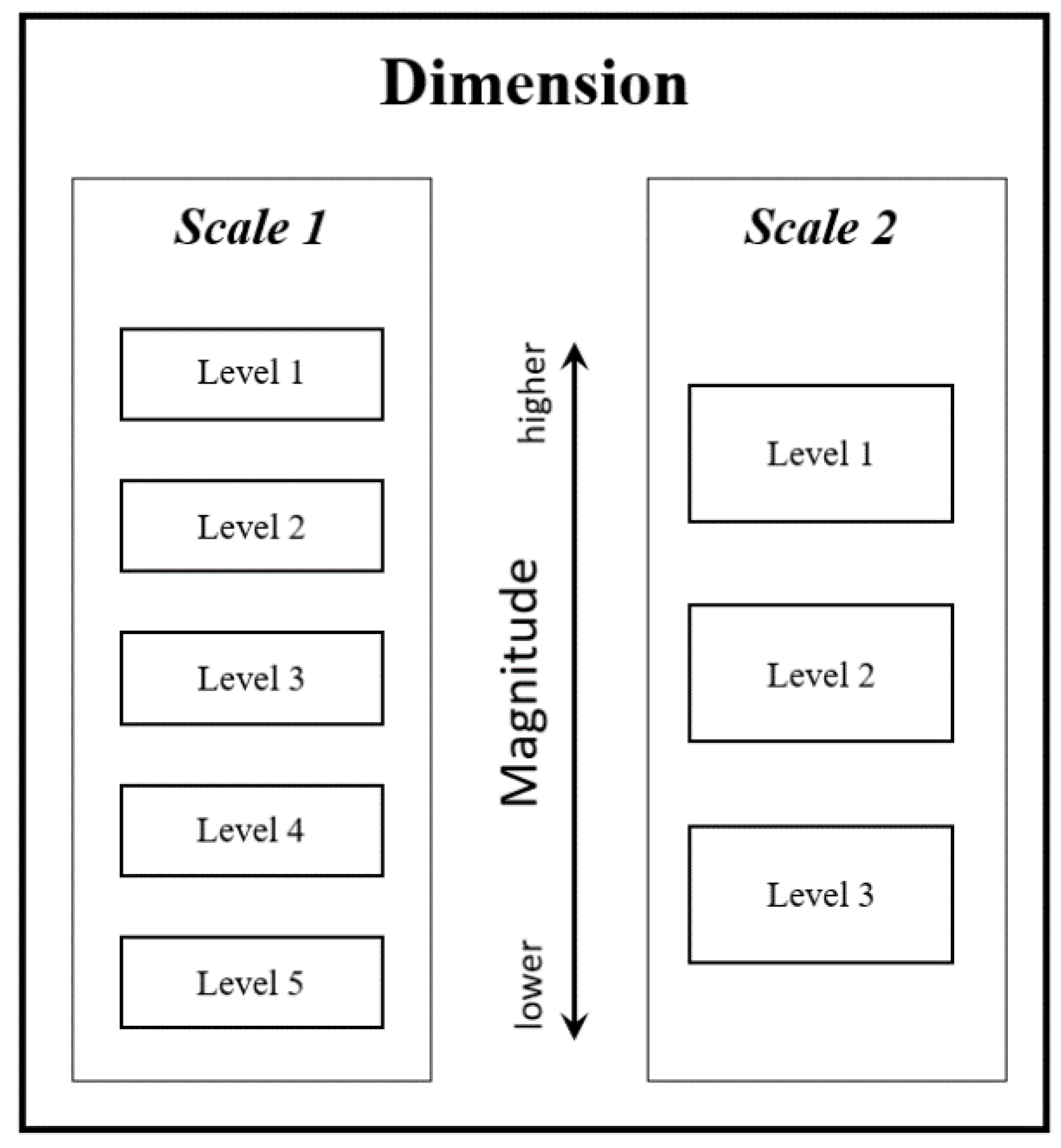
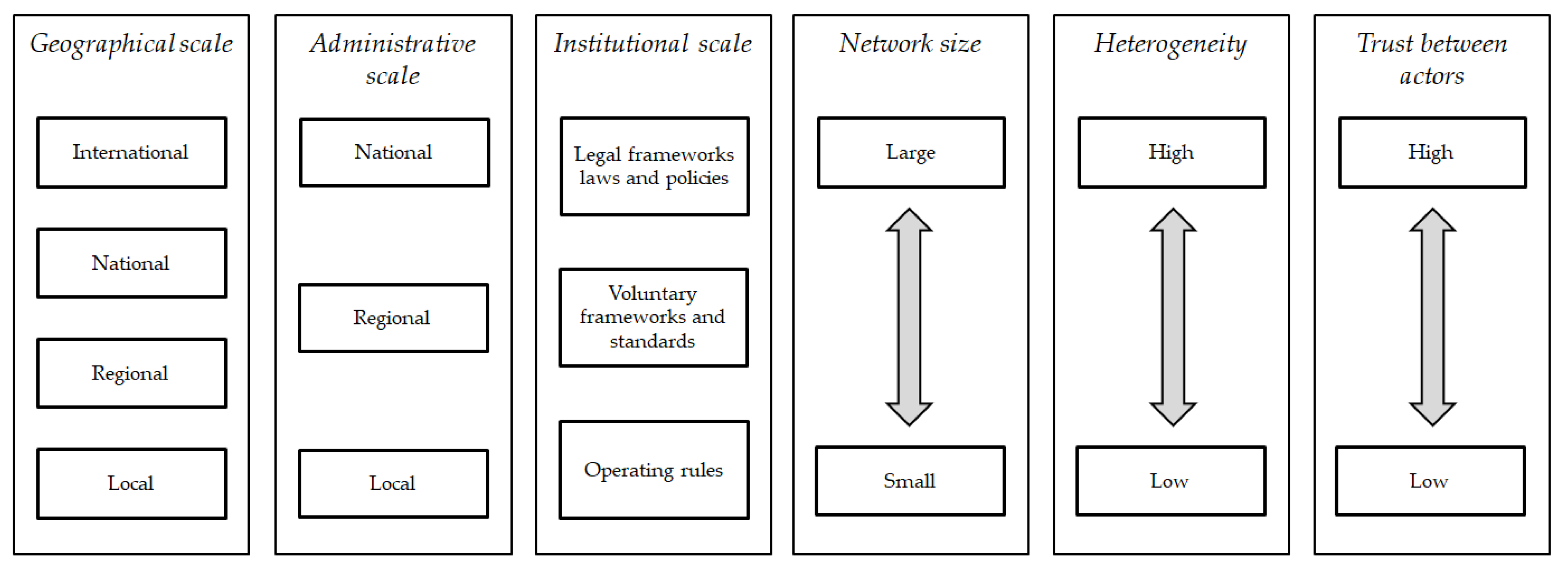
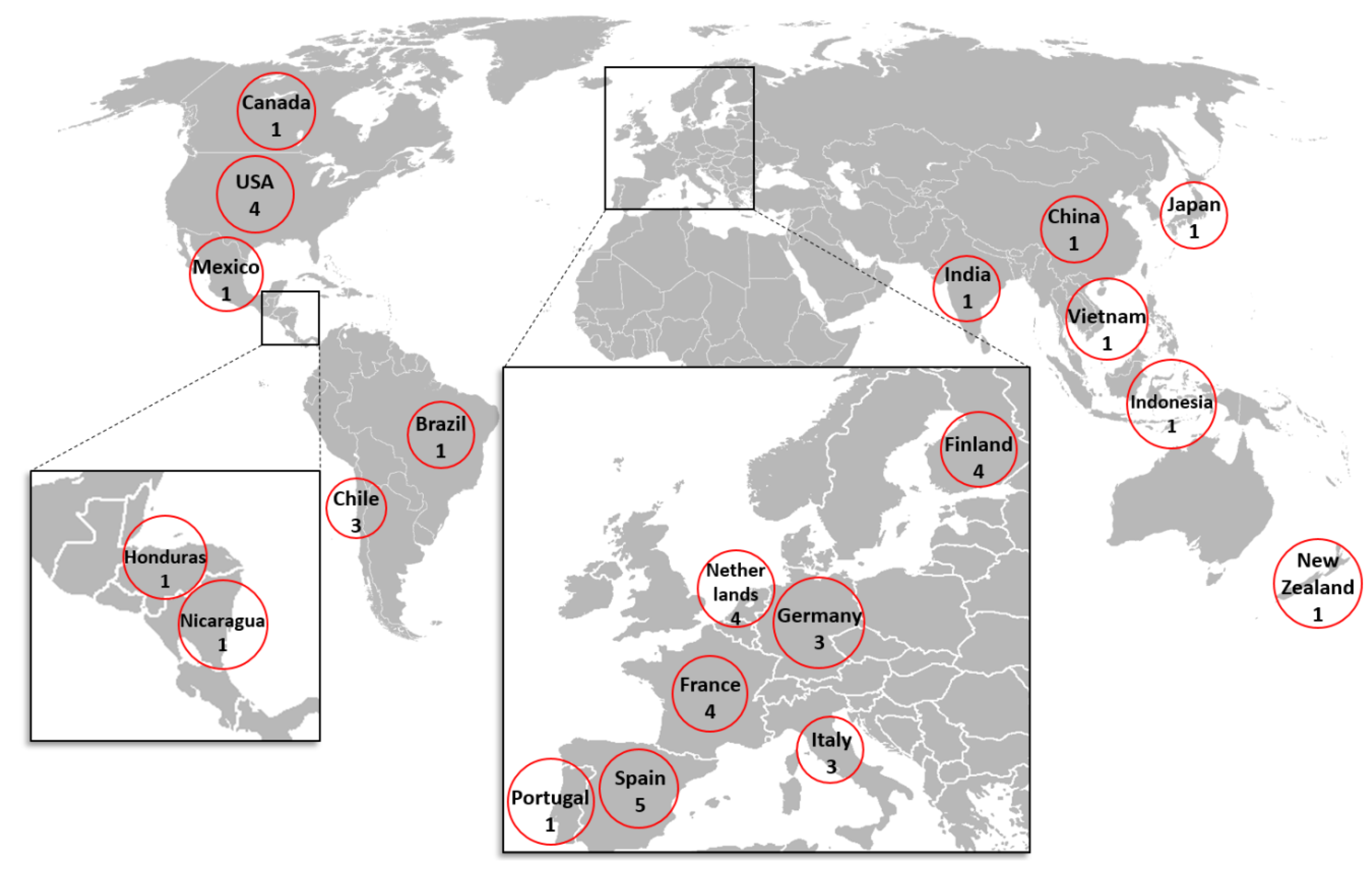
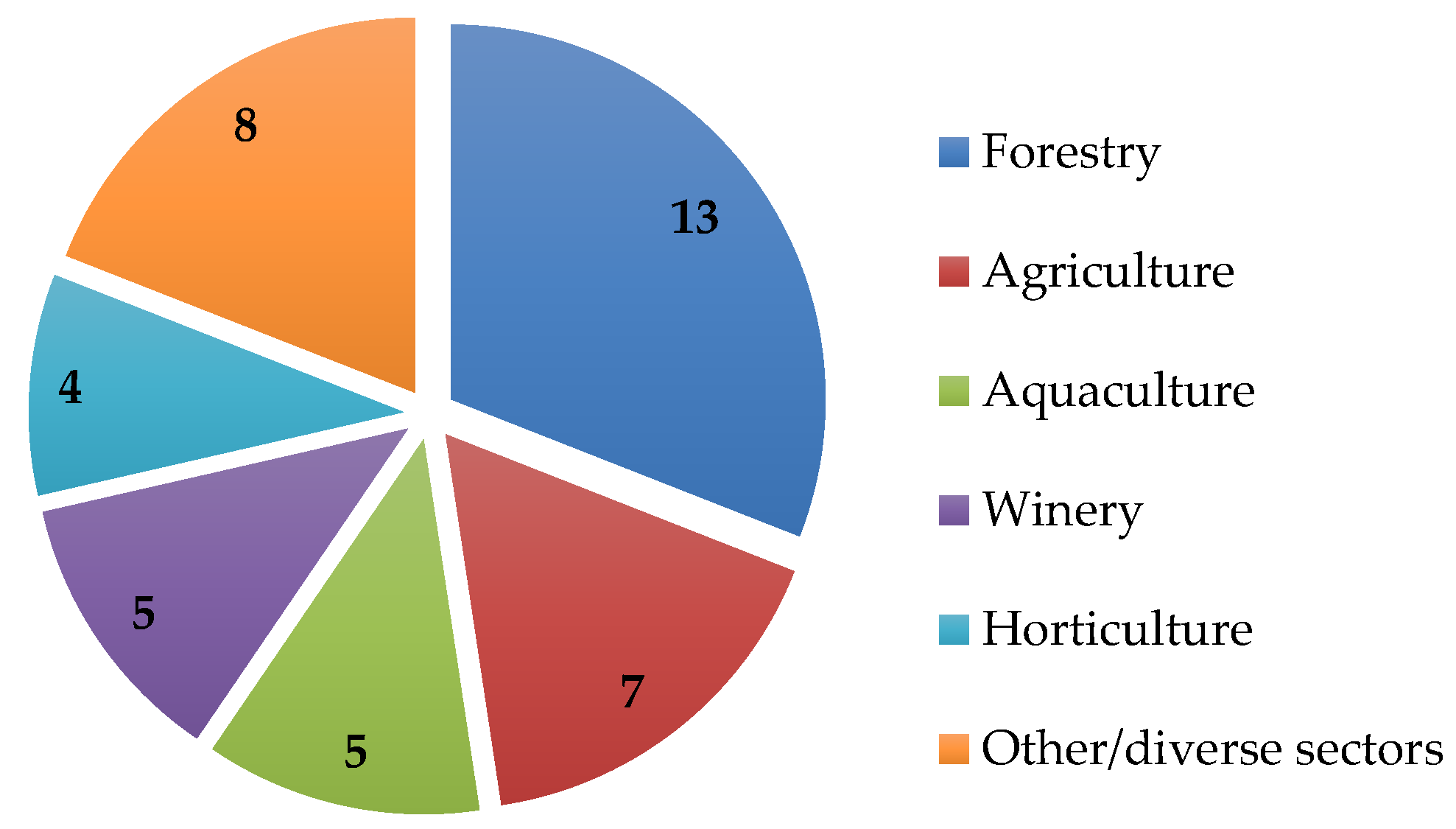
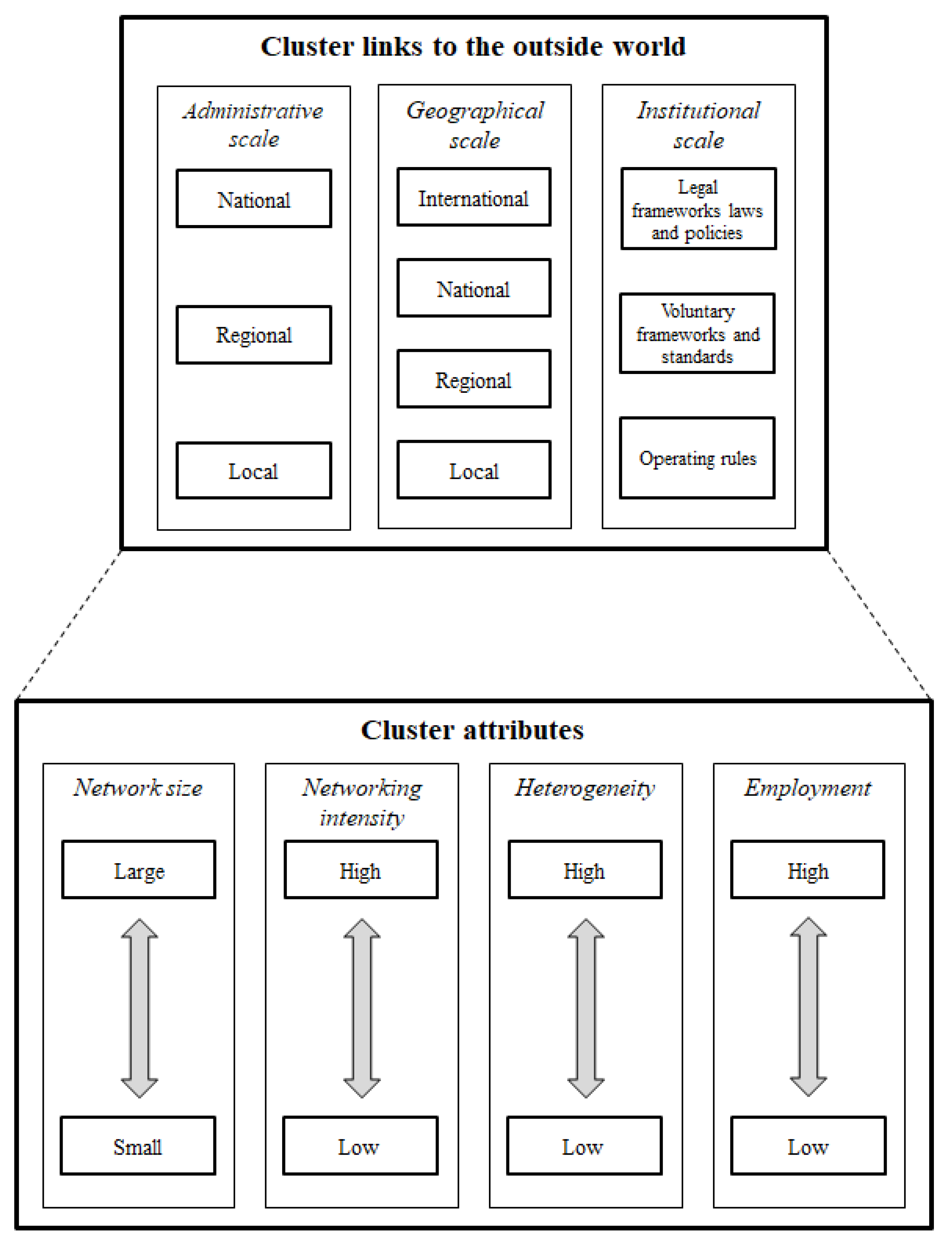
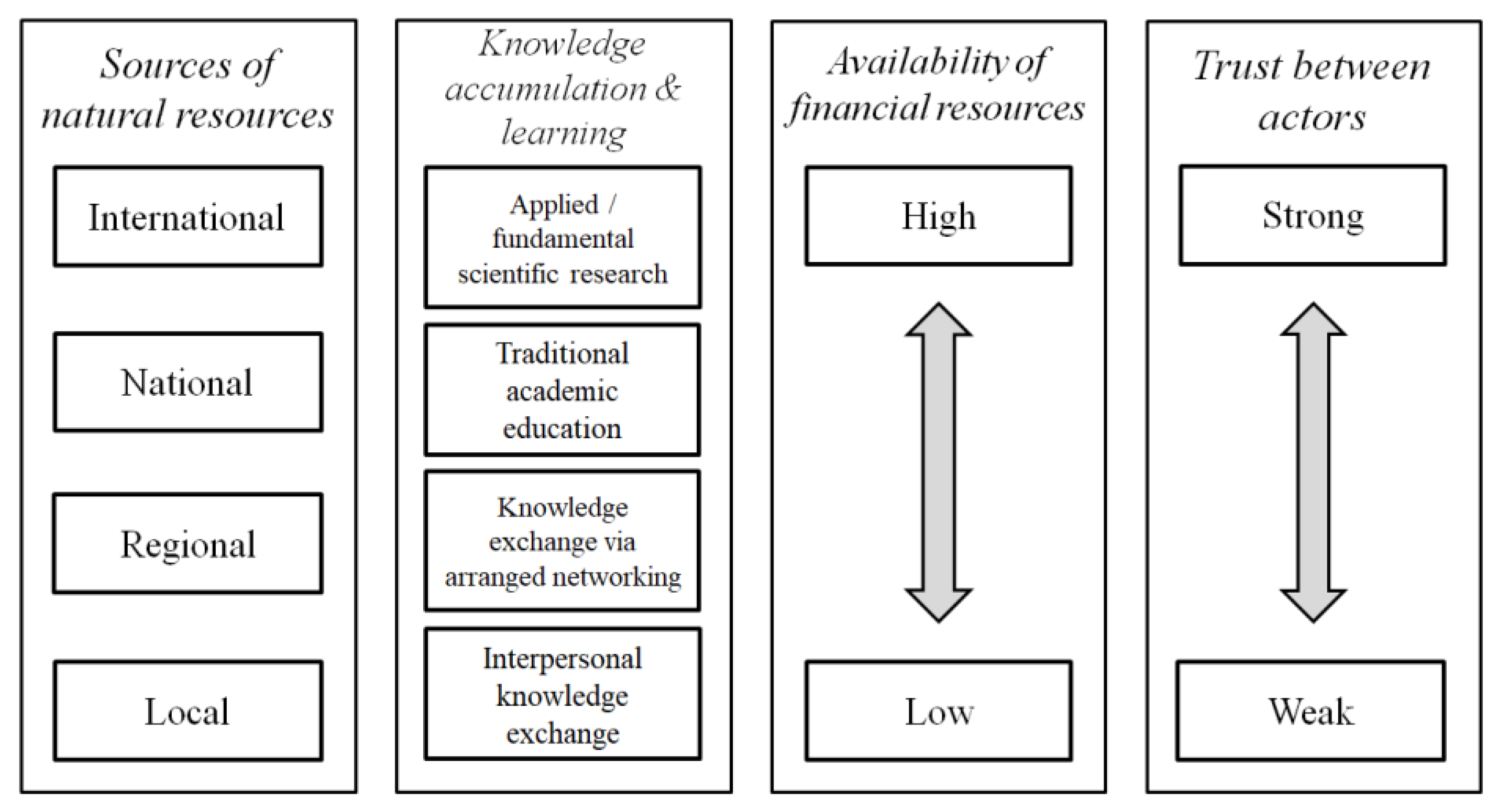
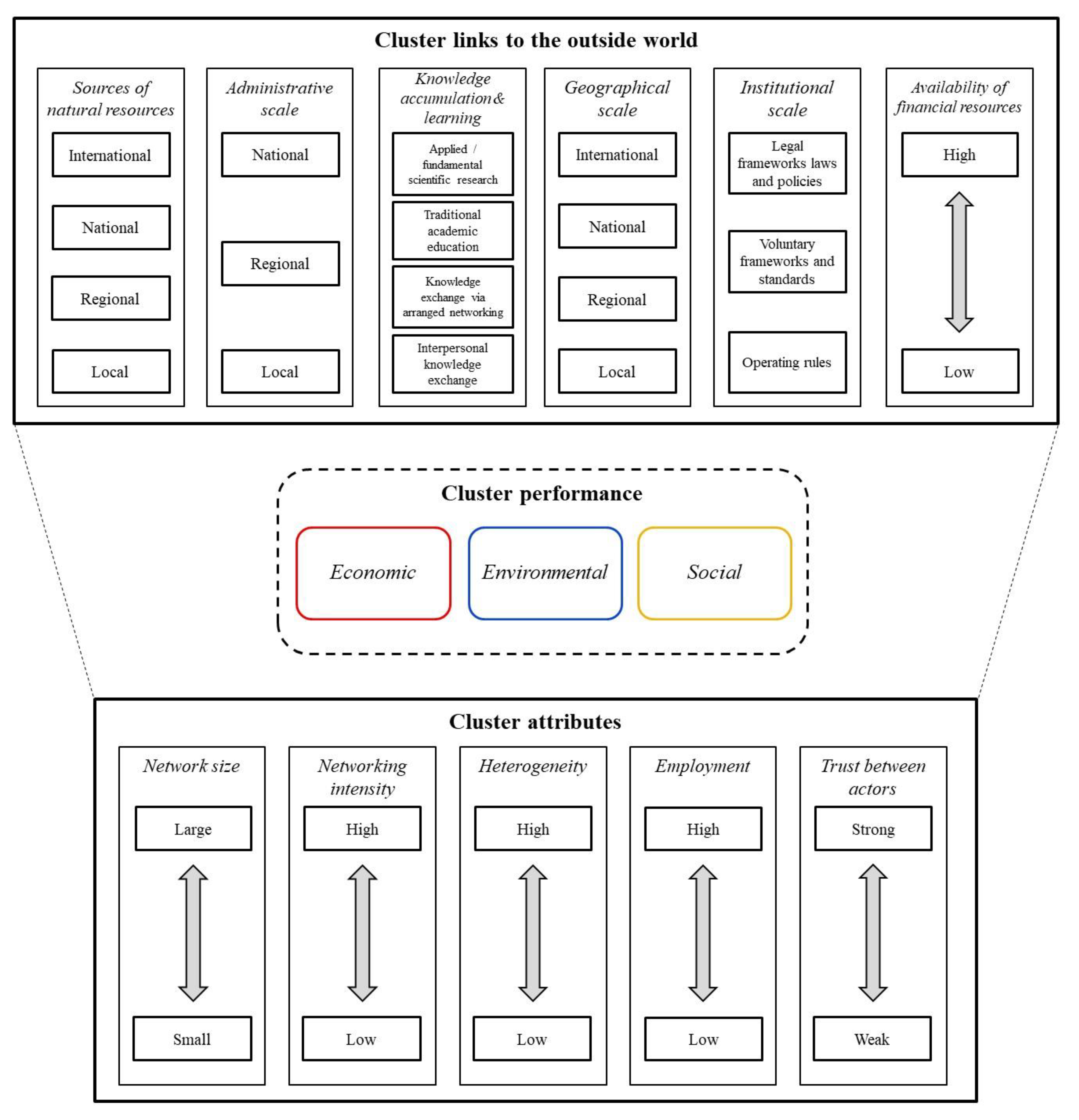
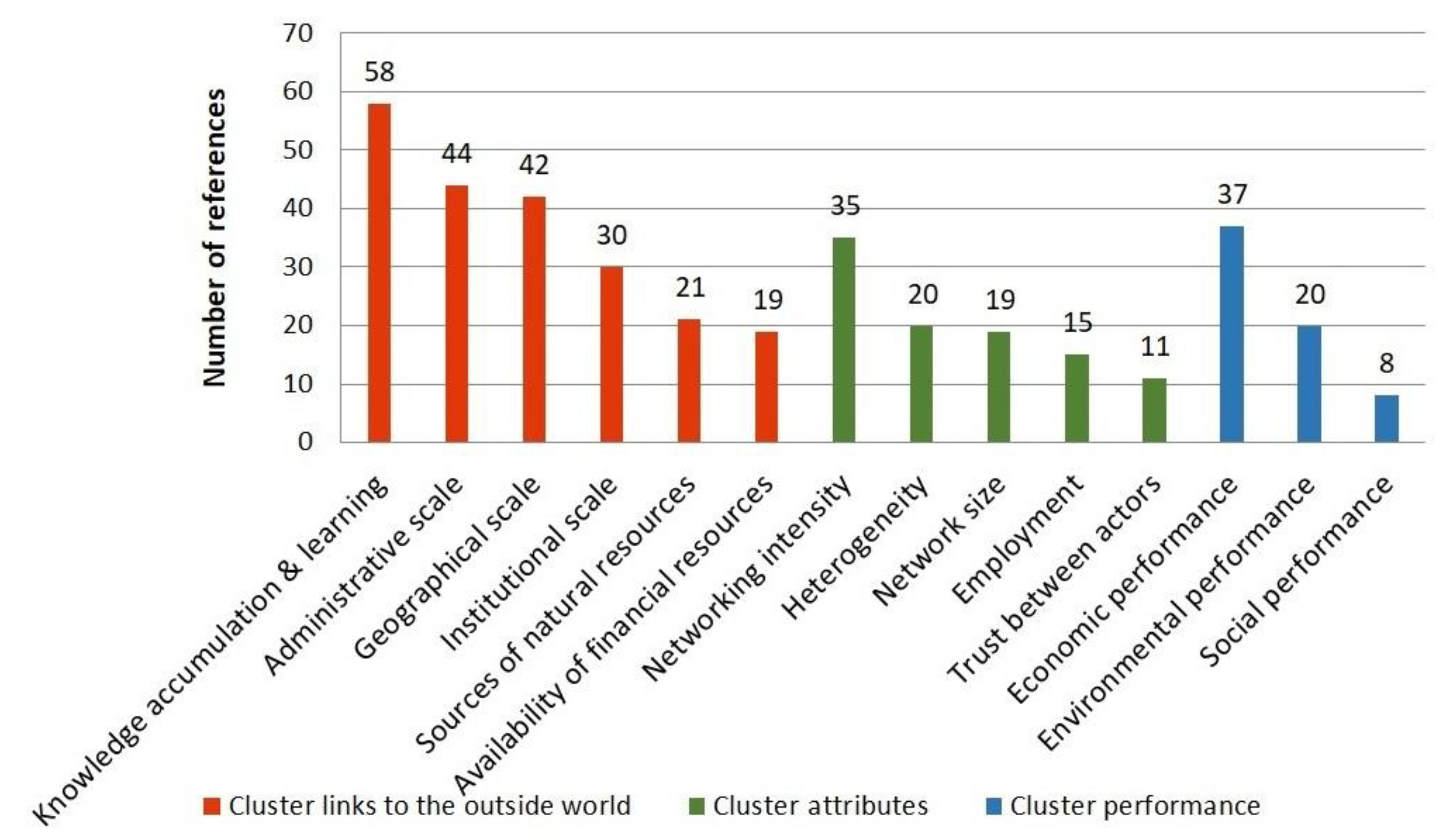
| Case Study | References to Economic Performance | Economic Performance | Environmental Performance | Social Performance |
|---|---|---|---|---|
| Cork cluster in Santa Maria da Feira, Portugal [52] | [cluster] is the main source of employment, added value, and exports, and the main support of this key sector in Portugal | Good | environmental benefits | social development |
| IAR-Pole, Hauts-de-France and Grand Est, Northern France [53] | complete innovation ecosystem on bioeconomy; largest bioeconomy network in France | Good | environmental benefits | |
| Forestry cluster in North Karelia, Finland [54] | (based on the comparative analysis of the cases in the article) | Good | pollution reduction | |
| Xylofutur cluster, Aquitaine, France [54] | (based on the comparative analysis of the cases in the article) all three segments of the triple helix model […] actively included in the sectoral development; cluster organization […] connects all three spheres and outreaches across sectoral and regional boundaries | Good | environmental benefits | |
| Forestry cluster in Baden-Württemberg, Germany [54] | (based on the comparative analysis of the cases in the article) strong sectoral organizations from all triple helix spheres | Good | utilizing renewable energies | |
| Bioeconomy cluster, Saxony, Saxony-Anhalt, Germany [55] | outstanding research in interdisciplinary teams; innovative industrial companies | Good | environmental preservation | |
| Southern and Western Catalan olive oil cluster, Spain [56] | favorable factors of Porter’s diamond of national competitive advantage; successful response of agents to changing conditions | Good | ||
| Waste Management EcoComplex, North Carolina, USA [50] | EcoComplex demonstrates leadership as a regional model and unique case study; key elements of triple helix working in collaboration | Good | striving towards zero waste | |
| Vegetable breeding cluster, the Netherlands [57] | this successful industry is playing important roles in the Dutch public domains; one of the most innovative in the world | Good | environmental benefits | |
| Paso Robles wine cluster, California, USA [51] | an image of a rising star in the wine world; a consistent increase in the number of wines and the average rating in Wine Spectator | Good | ||
| Cluster in Horticulture, Campo de Dalías, Almeria, Spain [58] | […] generating systemic and dynamic competitive advantages; the economic model […] has allowed growth of both the economy and the population of Almería | Good | environmental advantages | social benefits |
| Wine cluster in Rioja, Spain [59] | the production of wine in Rioja has developed a successful cluster, which has fostered innovation and regional competitiveness | Good | social development | |
| Wood cluster, Holmes, northeastern Ohio, USA [60] | unusual competitive success; the presence of this successful […] cluster helps sustain regional forest-based economies | Good | ||
| Wood waste processing cluster, Maniwa, Okayama Prefecture, western Japan [44] | the social capital […], the attitude and values […], institutions, and their relationships, contributed to the economic and social development, as well as environmental preservation, thus turning the Maniwa model to a success story | Good | CO2 reduction | social development |
| Furniture cluster, Brianza area, Italy [61] | the district of Brianza [has] a leading position in the production of high-quality furniture | Good | ||
| Forest and wood-processing cluster in North Rhine-Westphalia, Germany [62] | [cluster] is of nationwide and international relevance; highly significant for the regional economy and employment market | Good | environmental advantages | |
| Salmon industry cluster, Tenth region, Chile [63] | (based on the content of the article—no specific references) | Good | reduced environmental impact | |
| Agroindustry cluster, Curicó and Talca, Chile [63] | (based on the content of the article —no specific references) | Good | ||
| Tilapia production cluster in Olancho, Honduras [64] | successful adoption and retention of tilapia culture; […] facilitates technology adoption, production success, and marketing competence for all its members | Good | ||
| Sustainable agribusiness cluster, Kuningan District, West Java, Indonesia [65] | the multi-stakeholders [of the] cluster should develop better relationship, […] communication, […] collaboration; some parties still doubt and lack of trust (potential plurality challenge) | Average | environmental advantages | social benefits |
| Bioeconomy Campus, Tarvaala, Northern Central Finland [66] | somewhat lagging within the existing industrial structure; lacks the specificity of a distinct cluster and […] a market-driven perspective | Average | ||
| Wine cluster in Valle del Maule, Chile [67] | (based on the comparative analysis of the cases in the article) | Average | ||
| Wine cluster in Serra Gaúcha, Brazil [67] | (based on the comparative analysis of the cases in the article) | Average | ||
| The Canal Zone, Zeeland, The Netherlands [68] | occasional lack of government support; occasional difficulties in creating a cluster | Average | reduction of environmental impact | |
| Maine-et-Loire Horticultural Cluster, Angers, Anjou Region, Western France [69] | incompatibility between the industrial strategies of national and regional governments and local economic reality (potential plurality challenge) | Average | ||
| Shrimp processing cluster, Soc Trang Province, Vietnam [70] | lack of public awareness and community action (ignorance challenge) | Average | reducing pollution, protecting natural resources | |
| Forestry cluster, Kouvola, Southeast Finland [71] | policy instruments have [not] succeeded in […] systematically encouraging operators toward symbiosis-like activities | Average | environmental benefits | |
| Bordeaux Wines Terroir Cluster, France [72] | (based on the content of the article—no specific references) | Average | ||
| Nelson/Marlborough seafood cluster, Upper South Island, New Zealand [73] | incomplete local supply chain; inadequate educational programs | Average | contributed to slowing down the serious exploitation facing fisheries | social development, responsibility towards social and cultural conditions |
| Agroindustry cluster, Piceno district, the Marche Region, Italy [74] | (based on the content of the article—no specific references) | Average | ||
| Mechanical wood processing industry, Eastern Finland [75] | poorly structured production network, resulting in inefficient production processes; lack of trust | Average | ||
| Dairy cluster in Nueva Guinea, Nicaragua [76] | issues related to weak governance and an absence of necessary policies and programs | Average | ||
| Hassan Biofuel Park, Karnataka, India [77] | plurality challenge—discrepancy in the political intentions of different governmental levels regarding biodiesel: […] while India’s national and Karnataka’s state-level biodiesel policies set blending targets as their main priorities, the Hassan Bio-Fuel Park project is heralded by policy-makers for its intention to contribute to the eradication of rural poverty without affecting food production | Poor | ||
| Basque Country Wood cluster, Spain [54] | (based on the comparative analysis of the cases in the article) plurality challenge—complicated administrative system and a lack of trust and co-operation among the various stakeholders; governmental actors seem to be very weak when it comes to innovation support […] which is a severe obstacle for developing a support system in the sector | Poor | ||
| Catalonia Wood cluster, Spain [54] | (based on the comparative analysis of the cases in the article) weak sectoral innovation system | Poor | ||
| Agroindustry cluster in horticulture in Sinaloa, Mexico [78] | plurality challenge—lack of coordination among different administrative levels of government; weak economic effects, adverse social and ecological effects; […we have enough elements to qualify Sinaloa as a dysfunctional territory…] | Poor | adverse ecological effects | adverse social effects |
| Floriculture cluster, Maumee Valley, Ohio, USA [79] | persistent social and cultural barriers and [problems breaking the traditional values and business models]; plurality challenge—[the expectations of policy makers may not coincide with industry participants]; opposite expectations and perception between policy-makers and local stakeholders | Poor | ||
| Québec coastal maritime cluster, Canada [80] | no data | |||
| Rizhao Economic and Technology Development Area, Rizhao, China [81] | no data | striving toward minimal use of raw materials and energy, minimal production of waste and emissions | ||
| Biobased Economy Park, Cuijk, The Netherlands [82] | no data | CO2 reduction | social advantages | |
| Broad specialization cluster, Flemish-Dutch Delta, The Netherlands [83] | no data | |||
| Textile/clothing cluster, Como, Italy [61] | no data |
| Scale | Economic Performance | ||
|---|---|---|---|
| Good | Average | Poor | |
| Environmental performance | 63% | 38% | 20% * |
| Social performance | 21% | 15% | 20% * |
| Sources of Natural Resources | Administrative Scale | Knowledge Accumulation and Learning | Geographical Scale | Institutional Scale | Availability of Financial Resources | Economic Performance | Environmental Performance | Social Performance | Network Size | Networking Intensity | Heterogeneity | Employment | Trust between Actors | |
|---|---|---|---|---|---|---|---|---|---|---|---|---|---|---|
| Sources of natural resources | 1 | |||||||||||||
| Administrative scale | 0.11 | 1 | ||||||||||||
| Knowledge acc. and learning | 0.11 | 0.04 | 1 | |||||||||||
| Geographical scale | - | - | - | 1 | ||||||||||
| Institutional scale | 0 | 0.02 | 0.02 | - | 1 | |||||||||
| Availability of financial resources | 0.05 | 0.35 * | 0.25 | - | 0.42 ** | 1 | ||||||||
| Economic performance | 0.22 | 0.02 | 0.16 | - | −0.04 | −0.11 | 1 | |||||||
| Environmental performance | 0.19 | 0.51 ** | −0.14 | - | 0.05 | 0.28 | 0.06 | 1 | ||||||
| Social performance | 0 | 0.04 | 0.13 | - | 0.11 | 0.41 ** | −0.01 | 0.39 * | 1 | |||||
| Network size | 0.14 | −0.16 | −0.07 | - | −0.23 | −0.06 | 0.04 | −0.2 | 0.17 | 1 | ||||
| Networking intensity | 0.06 | −0.05 | 0.4 ** | - | −0.17 | −0.11 | 0.43 ** | −0.21 | −0.11 | −0.11 | 1 | |||
| Heterogeneity | 0.1 | −0.05 | 0.34 * | - | 0.05 | 0 | −0.09 | −0.15 | 0.02 | 0.19 | 0.17 | 1 | ||
| Employment | 0.25 | 0.19 | 0.24 | - | −0.05 | 0.52 ** | −0.03 | 0.18 | 0.4 ** | −0.08 | 0.2 | −0.01 | 1 | |
| Trust between actors | −0.05 | −0.16 | 0.11 | - | 0.01 | −0.11 | −0.12 | −0.24 | 0.12 | 0.22 | −0.02 | −0.03 | −0.22 | 1 |
© 2020 by the authors. Licensee MDPI, Basel, Switzerland. This article is an open access article distributed under the terms and conditions of the Creative Commons Attribution (CC BY) license (http://creativecommons.org/licenses/by/4.0/).
Share and Cite
Ayrapetyan, D.; Hermans, F. Introducing a Multiscalar Framework for Biocluster Research: A Meta-Analysis. Sustainability 2020, 12, 3890. https://doi.org/10.3390/su12093890
Ayrapetyan D, Hermans F. Introducing a Multiscalar Framework for Biocluster Research: A Meta-Analysis. Sustainability. 2020; 12(9):3890. https://doi.org/10.3390/su12093890
Chicago/Turabian StyleAyrapetyan, David, and Frans Hermans. 2020. "Introducing a Multiscalar Framework for Biocluster Research: A Meta-Analysis" Sustainability 12, no. 9: 3890. https://doi.org/10.3390/su12093890
APA StyleAyrapetyan, D., & Hermans, F. (2020). Introducing a Multiscalar Framework for Biocluster Research: A Meta-Analysis. Sustainability, 12(9), 3890. https://doi.org/10.3390/su12093890






